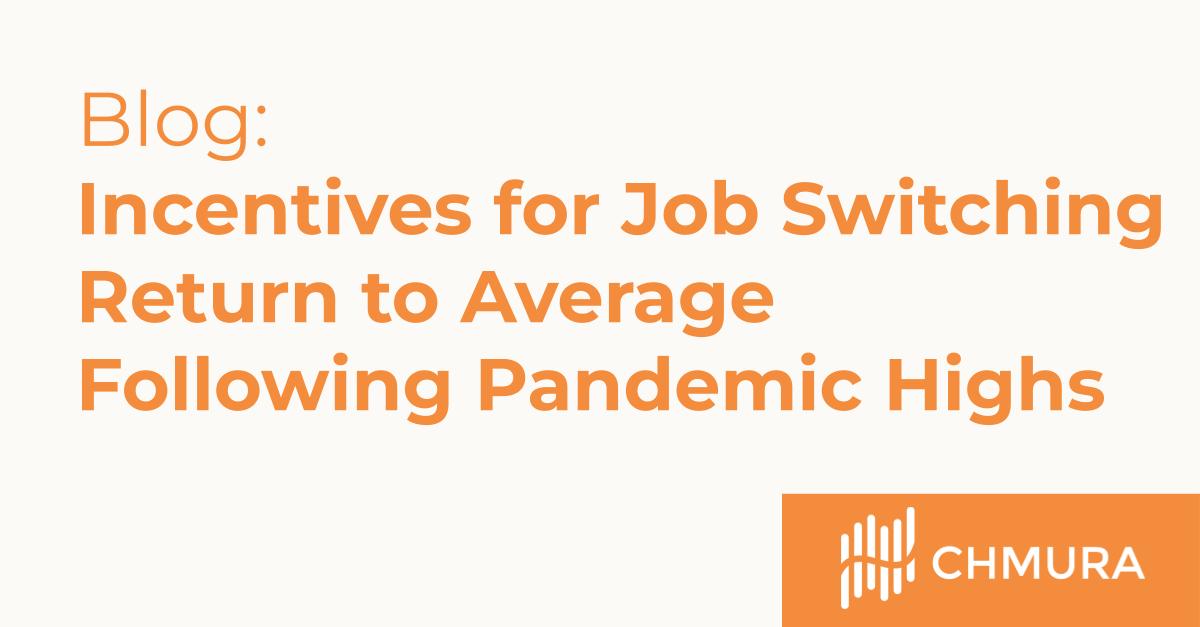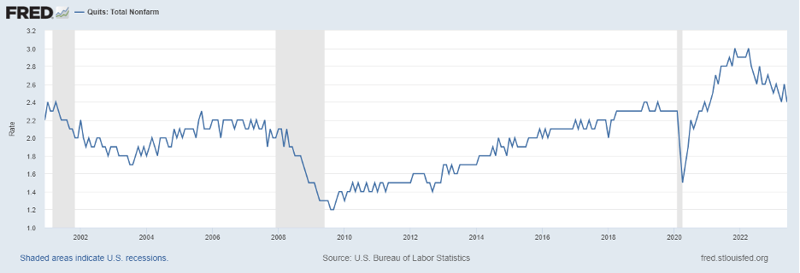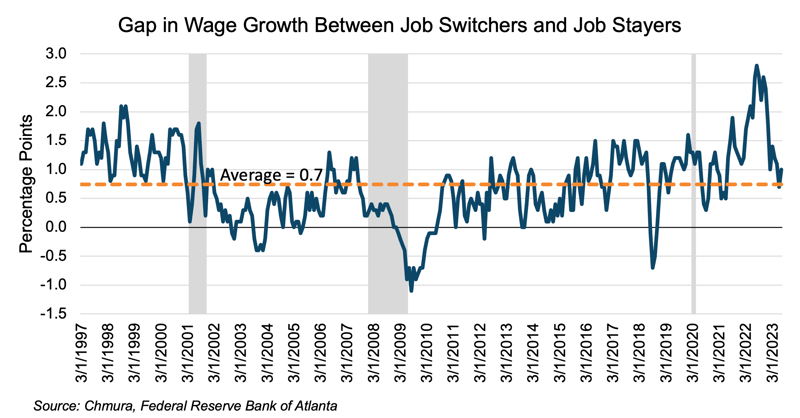Incentives for Job Switching Return to Average Following Pandemic Highs

By Patrick Clapp |
The resilience of the labor market has reopened hope for a possible soft landing, as the Federal Reserve tries to reign in inflation without causing massive unemployment. Employment is continuing to grow, albeit at a slowing pace, the unemployment rate is at historic lows, and labor force participation rates are holding steady. Amid these signals of a continued tight labor market, the number of people quitting their jobs has started to decline, and there are diminishing incentives for workers to switch roles and employers.
The quits rate gained attention as one of the key signals of labor market activity during the pandemic. As shown in the chart below, people tend to stay in their jobs during uncertain times such as a recession, and the number of people who quit plummeted at the start of 2020. However, as remote work opportunities opened and people reevaluated their careers during a period of upheaval and expanded government unemployment benefits, the “Great Resignation” drove the monthly quits rate to the highest recorded levels of 3.0% in November 2021 and April 2022. Since those record highs, the rate has steadily declined down to 2.4% as of June 2023, slightly above the historical average rate of 2.0% since the series began in 2000.

Workers quit jobs for several reasons, but the pandemic also offered a rare opportunity for workers in heavily impacted sectors to explore jobs in other occupations and industries. The tight labor market and rising inflation have also meant employers have had to increase their wage offerings to attract candidates. The effect on wages appears in the Atlanta Fed’s Wage Growth Tracker, which measures the nominal wage growth of individuals along several dimensions. It is particularly helpful in answering the question of wage growth for workers who stay in their jobs vs. the ones who quit (defined as either being in a different occupation or industry than a year ago, or with a change of employer or job duties within the past three months).
Since the Wage Growth Tracker series started in 1997, wages for job switchers have outpaced job stayers in all but three periods. The chart below shows the gap between the wage growth rates for these groups each month. For example, in March 1997, wage growth for job switchers was 5.2%, compared with 4.1% for job stayers, reflecting a gap of 1.1 percentage points. Any time the series dips below zero indicate a period where job stayers have seen faster wage growth than job switchers, typically during or following periods of job loss and reduced hiring such as the 2001 and 2007-2009 recessions (shown as grey bars in the chart).

Notably, wage growth for job switchers continued to outpace job stayers through the entire pandemic period. This is consistent with the high quits rate during this period—workers who quit in order to seek new opportunities were typically rewarded with better-paying jobs. The greatest difference came in August 2022, when wages for job switchers grew 8.4%, 2.8 percentage points higher than the 5.6% growth for job stayers. Since then, as both hiring and quits have slowed among economic uncertainty, the gap between switchers and stayers has gradually returned to hover around the historical average of 0.7 percentage points. For workers looking to maximize pay increases, job switching still represents a strong path to higher earnings. Looking ahead, as the job market softens, employers may expect to see reduced turnover, particularly if they can retain workers by offering competitive wage increases.
If you would like to explore how job market trends like quits rates may impact your organization, our expert economists are here to provide insight, through economic and fiscal impact studies, strategic planning, and industry analyses. Contact us today to discuss how Chmura's consulting team can help you. We'd love to talk to you.
Subscribe to the Weekly Economic Update
Subscribe to the Weekly Economic Update and get news delivered straight to your inbox.











